Abstract
Although mast cells and interferons are both involved in numerous immune and inflammatory responses, little is known about how microenvironmental factors such as interferons (IFNs) influence mast cell function. To study this question, sensitized peritoneal mast cells (greater than 98% purity) obtained from rats infected 4 weeks earlier with the parasite Nippostrongylus brasiliensis were preincubated for 24 hr with rat IFN-alpha/beta in RPMI-1640, then stimulated to degranulate with worm antigens. In the absence of antigen, IFN-alpha/beta had no noticeable effect on histamine release. However, in the presence of antigen, IFN-alpha/beta (150-1500 U/ml) inhibited histamine release in a dose-dependent manner (22.2 +/- 7.5% to 56.3 +/- 6.9%, n = 10). This inhibitory effect was neither heat (56 degrees for 1 hr) nor acid (pH 2 for 18 hr) labile, but was completely blocked by anti-IFN antibodies. In the presence of compound 48/80 (1 microgram/ml) or substance P (5 X 10(-5) M), IFN-alpha/beta was ineffective at modulating histamine release. Histamine release induced by antigen in the presence of the membrane phospholipid phosphatidyl-serine (30 micrograms/ml) was inhibited by IFN in a dose-dependent manner, but maximal inhibition (25.3 +/- 2.7%, n = 10) was reached at a lower concentration of IFN (750 U/ml) than when antigen was used alone. Therefore, rat IFN-alpha/beta appears to inhibit histamine release from rat mast cells in a dose- and stimulus-dependent manner and may do so by reducing the fluidity of the cell membrane.
Full text
PDF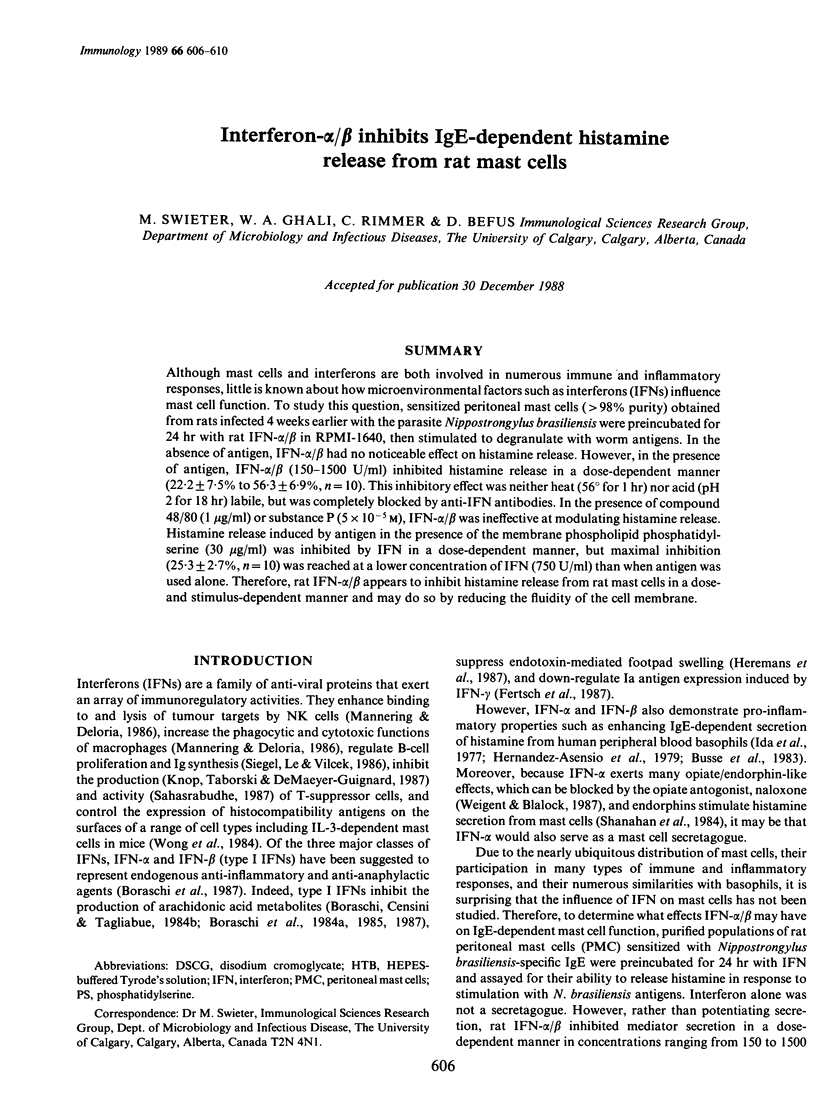
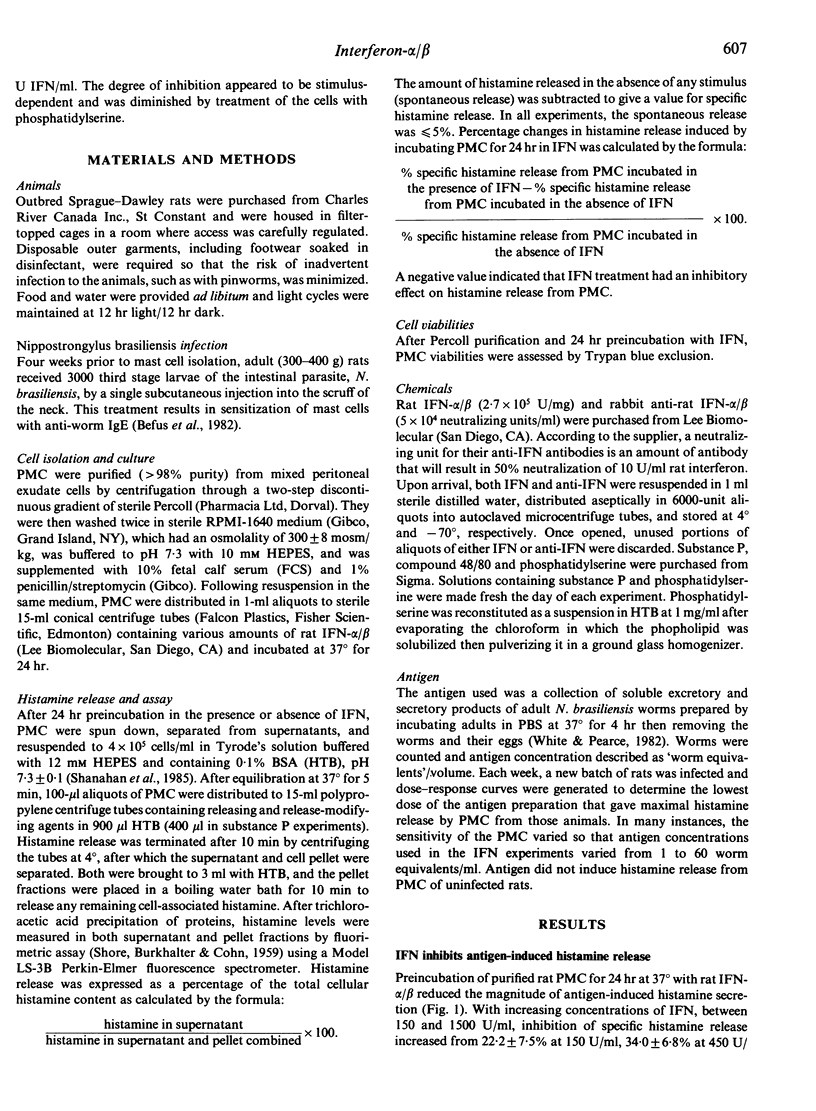
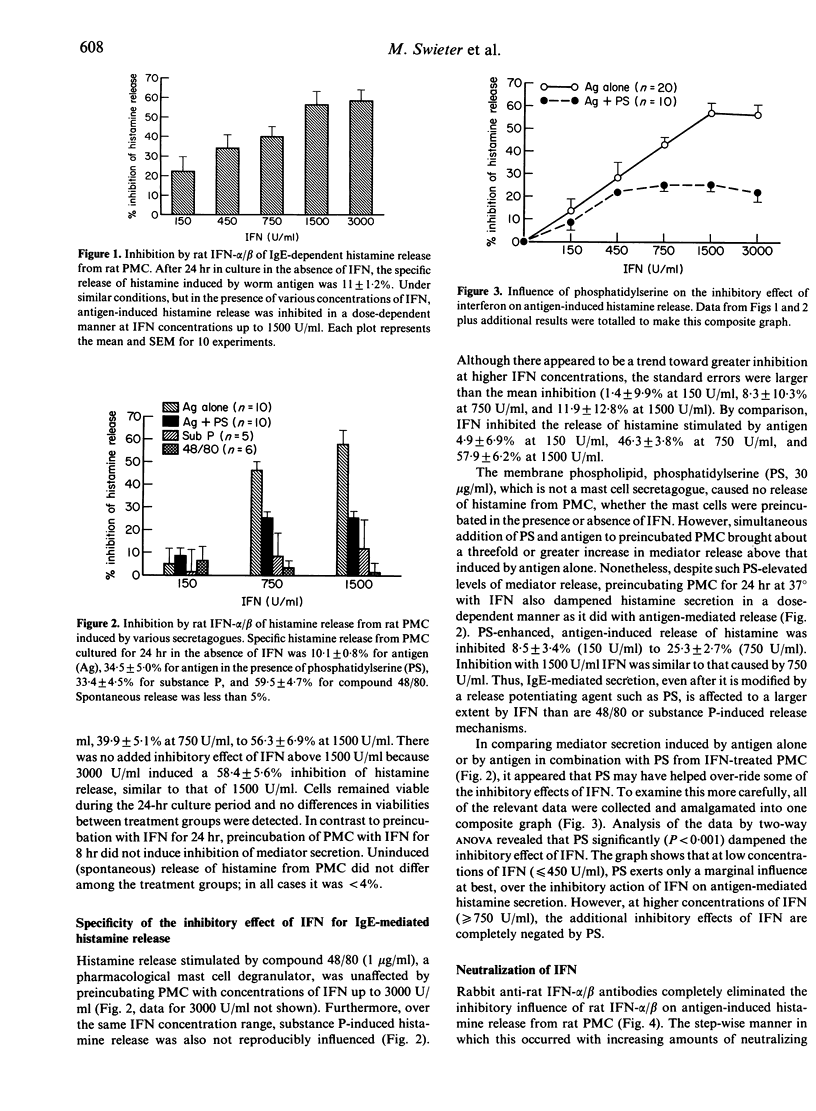
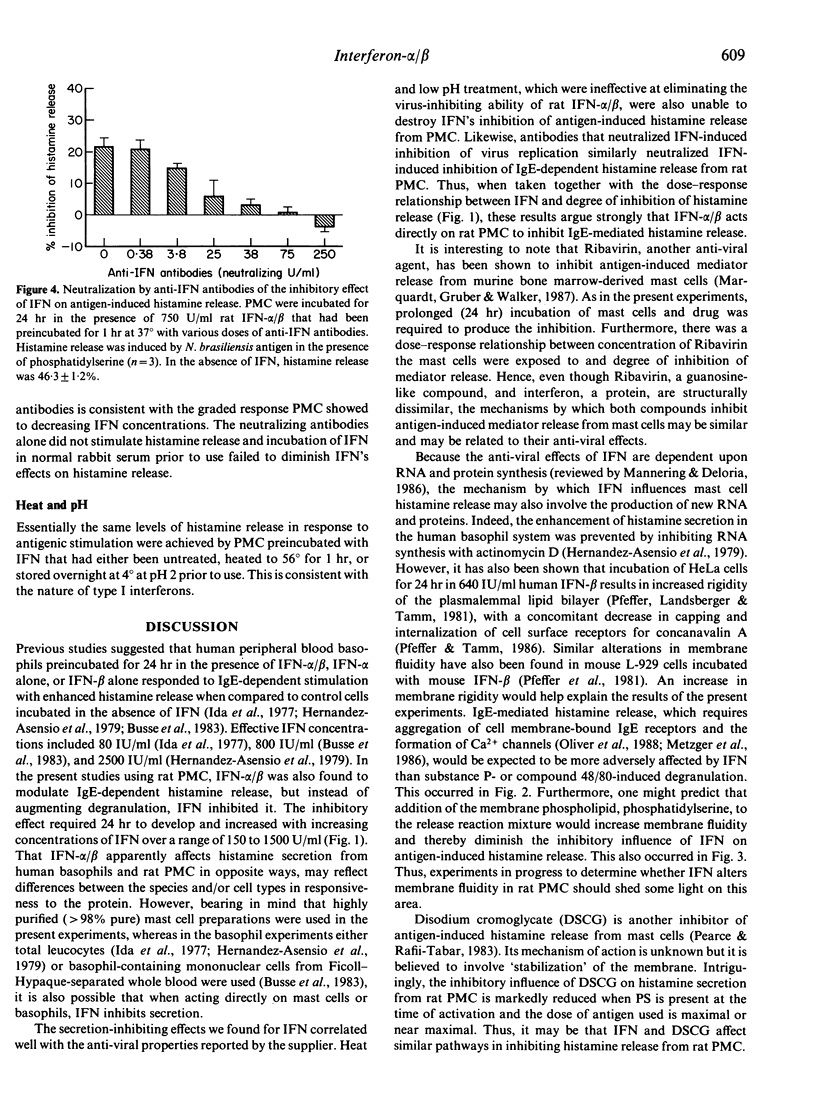
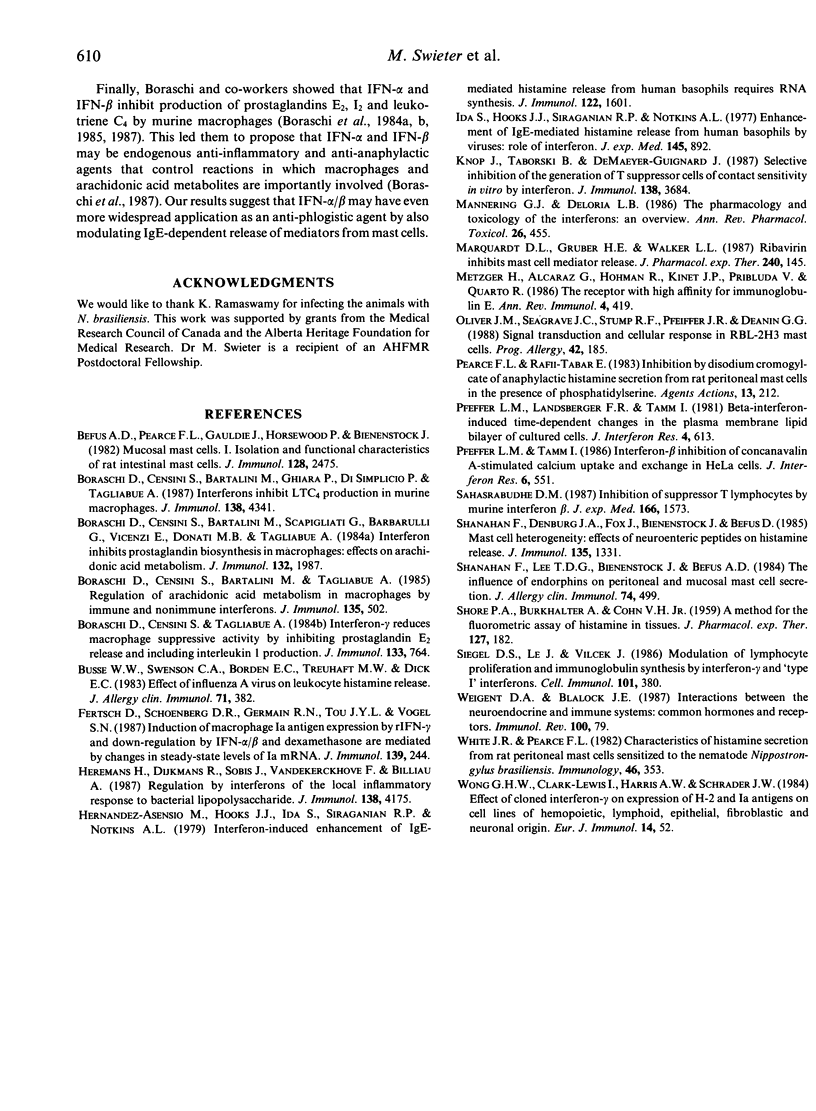
Selected References
These references are in PubMed. This may not be the complete list of references from this article.
- Befus A. D., Pearce F. L., Gauldie J., Horsewood P., Bienenstock J. Mucosal mast cells. I. Isolation and functional characteristics of rat intestinal mast cells. J Immunol. 1982 Jun;128(6):2475–2480. [PubMed] [Google Scholar]
- Boraschi D., Censini S., Bartalini M., Ghiara P., Di Simplicio P., Tagliabue A. Interferons inhibit LTC4 production in murine macrophages. J Immunol. 1987 Jun 15;138(12):4341–4346. [PubMed] [Google Scholar]
- Boraschi D., Censini S., Bartalini M., Scapigliati G., Barbarulli G., Vicenzi E., Donati M. B., Tagliabue A. Interferon inhibits prostaglandin biosynthesis in macrophages: effects on arachidonic acid metabolism. J Immunol. 1984 Apr;132(4):1987–1992. [PubMed] [Google Scholar]
- Boraschi D., Censini S., Bartalini M., Tagliabue A. Regulation of arachidonic acid metabolism in macrophages by immune and nonimmune interferons. J Immunol. 1985 Jul;135(1):502–505. [PubMed] [Google Scholar]
- Boraschi D., Censini S., Tagliabue A. Interferon-gamma reduces macrophage-suppressive activity by inhibiting prostaglandin E2 release and inducing interleukin 1 production. J Immunol. 1984 Aug;133(2):764–768. [PubMed] [Google Scholar]
- Busse W. W., Swenson C. A., Borden E. C., Treuhaft M. W., Dick E. C. Effect of influenza A virus on leukocyte histamine release. J Allergy Clin Immunol. 1983 Apr;71(4):382–388. doi: 10.1016/0091-6749(83)90066-0. [DOI] [PubMed] [Google Scholar]
- Fertsch D., Schoenberg D. R., Germain R. N., Tou J. Y., Vogel S. N. Induction of macrophage Ia antigen expression by rIFN-gamma and down-regulation by IFN-alpha/beta and dexamethasone are mediated by changes in steady-state levels of Ia mRNA. J Immunol. 1987 Jul 1;139(1):244–249. [PubMed] [Google Scholar]
- Heremans H., Dijkmans R., Sobis H., Vandekerckhove F., Billiau A. Regulation by interferons of the local inflammatory response to bacterial lipopolysaccharide. J Immunol. 1987 Jun 15;138(12):4175–4179. [PubMed] [Google Scholar]
- Hernandez-Asensio M., Hooks J. J., Ida S., Siraganian R. P., Notkins A. L. Interferon-induced enhancement of IgE-mediated histamine release from human basophils requires RNA synthesis. J Immunol. 1979 Apr;122(4):1601–1603. [PubMed] [Google Scholar]
- Ida S., Hooks J. J., Siraganian R. P., Notkins A. L. Enhancement of IgE-mediated histamine release from human basophils by viruses: role of interferon. J Exp Med. 1977 Apr 1;145(4):892–906. doi: 10.1084/jem.145.4.892. [DOI] [PMC free article] [PubMed] [Google Scholar]
- Knop J., Taborski B., DeMaeyer-Guignard J. Selective inhibition of the generation of T suppressor cells of contact sensitivity in vitro by interferon. J Immunol. 1987 Jun 1;138(11):3684–3687. [PubMed] [Google Scholar]
- Mannering G. J., Deloria L. B. The pharmacology and toxicology of the interferons: an overview. Annu Rev Pharmacol Toxicol. 1986;26:455–515. doi: 10.1146/annurev.pa.26.040186.002323. [DOI] [PubMed] [Google Scholar]
- Marquardt D. L., Gruber H. E., Walker L. L. Ribavirin inhibits mast cell mediator release. J Pharmacol Exp Ther. 1987 Jan;240(1):145–149. [PubMed] [Google Scholar]
- Metzger H., Alcaraz G., Hohman R., Kinet J. P., Pribluda V., Quarto R. The receptor with high affinity for immunoglobulin E. Annu Rev Immunol. 1986;4:419–470. doi: 10.1146/annurev.iy.04.040186.002223. [DOI] [PubMed] [Google Scholar]
- Oliver J. M., Seagrave J., Stump R. F., Pfeiffer J. R., Deanin G. G. Signal transduction and cellular response in RBL-2H3 mast cells. Prog Allergy. 1988;42:185–245. [PubMed] [Google Scholar]
- Pearce F. L., Rafii-Tabar E. Inhibition by disodium cromoglycate of anaphylactic histamine secretion from rat peritoneal mast cells in the presence of phosphatidylserine. Agents Actions. 1983 Apr;13(2-3):212–215. doi: 10.1007/BF01967334. [DOI] [PubMed] [Google Scholar]
- Pfeffer L. M., Landsberger F. R., Tamm I. Beta-interferon-induced time-dependent changes in the plasma membrane lipid bilayer of cultured cells. J Interferon Res. 1981;1(4):613–620. doi: 10.1089/jir.1981.1.613. [DOI] [PubMed] [Google Scholar]
- Pfeffer L. M., Tamm I. Interferon-beta inhibition of concanavalin A-stimulated calcium uptake and exchange in HeLa cells. J Interferon Res. 1986 Oct;6(5):551–556. doi: 10.1089/jir.1986.6.551. [DOI] [PubMed] [Google Scholar]
- SHORE P. A., BURKHALTER A., COHN V. H., Jr A method for the fluorometric assay of histamine in tissues. J Pharmacol Exp Ther. 1959 Nov;127:182–186. [PubMed] [Google Scholar]
- Sahasrabudhe D. M. Inhibition of suppressor T lymphocytes by murine interferon beta. J Exp Med. 1987 Nov 1;166(5):1573–1578. doi: 10.1084/jem.166.5.1573. [DOI] [PMC free article] [PubMed] [Google Scholar]
- Shanahan F., Denburg J. A., Fox J., Bienenstock J., Befus D. Mast cell heterogeneity: effects of neuroenteric peptides on histamine release. J Immunol. 1985 Aug;135(2):1331–1337. [PubMed] [Google Scholar]
- Shanahan F., Lee T. D., Bienenstock J., Befus A. D. The influence of endorphins on peritoneal and mucosal mast cell secretion. J Allergy Clin Immunol. 1984 Oct;74(4 Pt 1):499–504. doi: 10.1016/0091-6749(84)90385-3. [DOI] [PubMed] [Google Scholar]
- Siegel D. S., Le J., Vilcek J. Modulation of lymphocyte proliferation and immunoglobulin synthesis by interferon-gamma and "type I" interferons. Cell Immunol. 1986 Sep;101(2):380–390. doi: 10.1016/0008-8749(86)90151-6. [DOI] [PubMed] [Google Scholar]
- Weigent D. A., Blalock J. E. Interactions between the neuroendocrine and immune systems: common hormones and receptors. Immunol Rev. 1987 Dec;100:79–108. doi: 10.1111/j.1600-065x.1987.tb00528.x. [DOI] [PubMed] [Google Scholar]
- White J. R., Pearce F. L. Characteristics of histamine secretion from rat peritoneal mast cells sensitized to the nematode Nippostrongylus brasiliensis. Immunology. 1982 Jun;46(2):353–359. [PMC free article] [PubMed] [Google Scholar]
- Wong G. H., Clark-Lewis I., Harris A. W., Schrader J. W. Effect of cloned interferon-gamma on expression of H-2 and Ia antigens on cell lines of hemopoietic, lymphoid, epithelial, fibroblastic and neuronal origin. Eur J Immunol. 1984 Jan;14(1):52–56. doi: 10.1002/eji.1830140110. [DOI] [PubMed] [Google Scholar]


